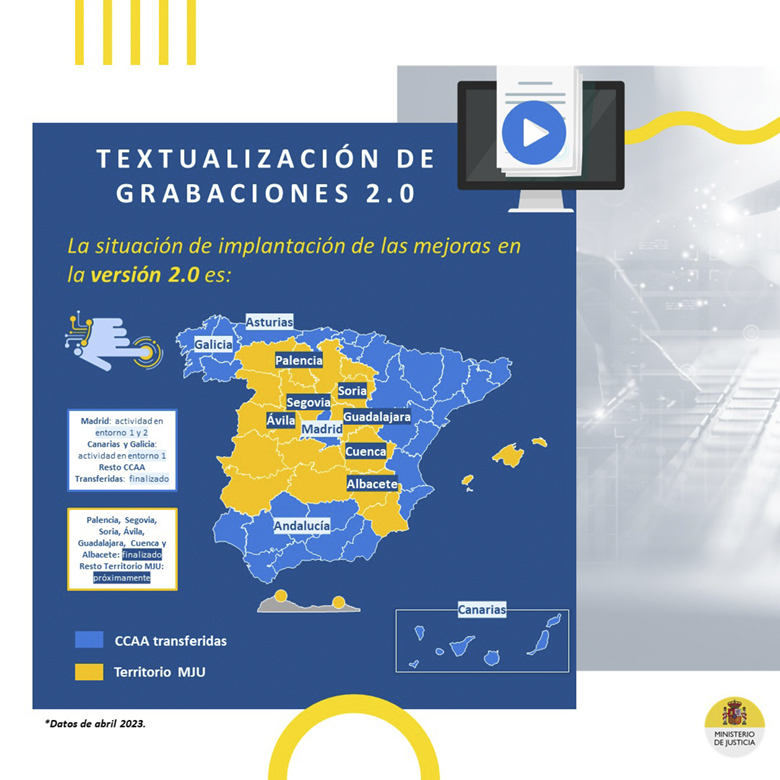01
The digital revolution in public services
The application of ICT (Information and Communication Technologies) is transforming public services and the way in which citizens relate to the Administration. The COVID-19 pandemic has accelerated the technological development processes that were already underway.
"Digitalisation is the new industrial revolution. It changes the way work, consumption, culture, and even private life is introduced into the networks. Proper data processing allows for efficiency gains [...] but it also implies challenges for the rule of law" Justice 2030 Plan, Ministry of Justice of the Spanish Government
The modernisation of the administration of justice began in Spain in 2001, with the signing of the State Pact for the Reform of Justice, and the laws that were subsequently passed: in 2003, which established the right of citizens to communicate by telematic means with the administration of justice, and in 2011, to specifically regulate the use of ICT in the judicial sphere.
In 2011, as a pilot experience, the E-Court File system began to be implemented in the contentious-administrative and social jurisdictions of the National High Court. Three laws on judicial efficiency (organisational, digital and procedural) are currently being processed in Parliament, which define the framework of what the judicial administration of the 21st century aspires to be, and which is included in the Justice 2030. This is a state strategy approved in 2020, and subsequently supported by European Next Generation funds through the Transformation, Recovery and Resilience Plan with different country projects.
02
Anatomy of a new format

In summary, the diagnosis and starting point of Justice 2030 is that the organisation and functioning of the judicial administration no longer responds to the needs and challenges of today's society, which is more complex and in the midst of a "change of cycle", marked by the ecological transition and digitalisation. This complexity results into a constant increase in litigation (volume of lawsuits), which the increase in human and material resources is not sufficient to resolve quickly.
"The aim of the justice system is to act quickly, efficiently and with quality, with more modern methods and less complicated procedures. [...] Implementing this ambitious and far-reaching reform project is a real matter of State". Spanish State Pact for Justice Reform, May 28, 2001

Thus, according to Justice 2030, the causes of inefficiencies lie in structural factors, such as a judicial organisation that is "not very flexible" and too "compartmentalised", with "outdated rules and procedures" that are not "aligned" with European law.
Added to this is the challenge of co-governance: in a decentralised country like Spain, with 17 autonomous communities plus two autonomous cities, twelve have transferred competences in justice: Madrid, Catalonia, Andalusia, Galicia, Aragon, Valencia, the Canary Islands, the Basque Country, Navarre, La Rioja, Cantabria and Asturias. The remainder are in the hands of the central government ("Ministry territory").
This results, for example, in the existence of seven different (and non-interoperable) systems for procedural management. In this sense, Ineco is involved in interoperability, one of the "country projects" of Justice 2030, which aims to build a model in which procedural management systems are fully interoperable, not only among themselves within the judicial sphere, but also with the rest of the digital ecosystem of Justice.
Spanish Justice Figures | |
⚖ More than 254,000 public employees: ⚖ 115,000 lawyers, 11,000 solicitors, 3,000 notaries and 1,100 registrars. ⚖ 3,627 courts of first instance and 7,600 magistrates' courts. | ⚖ 6.6 million new court cases in 2022, 6.5% more than the previous year. un 6,5 % más que el año anterior. ⚖ 6.4 million cases resolved by 2022 million cases resolved by 2022. ⚖ 3.3 million lawsuits pending on December 31, 7.9% more than in 2021. |
Source: General Council of the Judiciary | |
03
Some good changes

Modernisation thus has three closely interconnected strands: technological, organisational, and procedural. Each of which is regulated and defined by the three pending laws.
The organisational reform aims to reduce the current territorial dispersion and compartmentalisation of resources and functions. It is based on a new model, the Judicial Office instead of the traditional court, and on the implementation of the Courts of First Instance, one per judicial district, which will reduce the current number of more than 3,600 courts to 431, a figure closer to that of countries such as Italy, France or Germany. Moreover, they will be collegial rather than single-person bodies, which will allow for a redistribution of the workload.
In the smaller municipalities, the Justice Offices will replace and improve the services currently offered by the 7,600 peace courts, which were created in the 19th century. The new model will provide service to some 14 million inhabitants throughout Spain.
In terms of procedural reform, the aim is to simplify and optimise procedures at all stages of the process, with measures such as non-judicial mediation (to reduce the number of lawsuits), assigning prosecutors the investigative functions in a process together with the creation of the new figures of the judge of guarantees and the preliminary hearing judge, and improving the location and management of intervened assets.

The third pillar of judicial modernisation is the digital one, which provides the technological support for the other two, and involves a complete paradigm shift, in which what matters is the data, not the physical document.
The aim is that the new digital environment will translate, in practice, into faster and simpler procedures and processes, both for citizens and for judicial operators, with a consequent improvement in the efficiency of the system as a whole.
Achieving this goal is a highly complex process of which Ineco has been a part for seven years, with a team that currently comprises more than 500 people. It provides different services in a wide range of initiatives, under the leadership of the current General Director for the Digital Transformation of the Administration of Justice.
04
Technology on the witness stand

The company is in charge of several offices supporting ICT governance and project and service management support, supplier performance monitoring, change management and the Corporate Platform and Application Development Centre, among others. In addition, it is responsible for the digitalisation and cataloguing of judicial files, a technological innovation laboratory and technical support in the field of cybersecurity.
The epicentre of the digital transformation of Justice is the E-Court File. In 2016, Ineco began work on its evolution, and on many other related technological developments, such as the adaptation of the ACCEDA platform for professionals' access to electronic documentation, and improvements and updates to the Horus judicial file viewer.
Another key initiative in which Ineco collaborates is the EVID (Virtual Digital Interaction Desk), a web tool that began to be implemented in 2020 as a digital immediacy system for telematic hearings and which, thanks to the Cl@ve Justicia electronic identification and signature system, makes digital presence possible. In other words, it enables the relationship between the citizen and the judicial officer through a secure conference call system.

More recently, the National High Court has also been a pioneer in the pilot tests of the "Biometric Kiosks" project, carried out in 2022, in which the company has also been involved, and which consist of the use of facial recognition as a system for appearing in person at a judicial office to carry out procedures, comply with precautionary measures or recover documents electronically.
More than 444,000 digital interaction actions were carried out in 2022, saving 8,880 km of journeys and benefited more than 320,000 people. Some 600,000 views were textualised and more than 93,000 accesses to the E-Court File were registered. Source: Avances Transformación Digital de la Justicia, Ministry of Justice, October 2022.
In terms of process robotisation, in 2021 the company carried out the automatic mass cancellation of the criminal records of a quarter of a million citizens who have already served their criminal responsibility, saving more than 7,000 hours of work for civil servants, who have been able to devote their time to less mechanical and more value-added tasks.
Another "intelligent" tool that Ineco is also working on is the textualisation of courtroom recordings, i.e., the transcription into text of video or audio recordings of trials, hearings and appearances. These transcriptions are incorporated into the E-Court File through the Horus Viewer. First tests were carried out in 2021 in the Community of Madrid. It has already been implemented throughout the "Ministry territory" and is in progress in the remaining Autonomous Communities.

The exchange of information between different systems and databases is another key factor in streamlining the judicial inner workings. Ineco is working on projects such as the technological migration from Minerva, (the common procedural management system implemented in the "Ministry territory") to the new Atenea. Fully compatible with its predecessor, but significantly improved from a technological and usability perspective, it began in 2019 with an implementation plan that is scheduled for completion in 2024.
The company has also been working since 2016 on the development and progressive deployment of SIRAJ, the Integrated System of Administrative Records to Support the Administration of Justice. Updated in 2022 to the SIRAJ2 version, it unifies the following central registers: final sentences for minors, convicted persons, sex offenders and human trafficking, precautionary measures, protection of victims of domestic violence and civil rebels.
On the other hand, the ECRIS (European Criminal Record System), which acts as the standard system for the exchange of criminal records in the European Union, in its third phase of deployment also allows the exchange of fingerprints with eight European countries. Its most recent version, ECRIS 2, was implemented in June 2022, and has been developed entirely by Ineco, with Spain being the European Union country that has led this project.
Finally, from mid-2023 it is planned to extend the project to third-country nationals convicted in Europe, which would represent a milestone in the exchange of criminal records.






